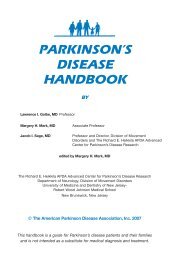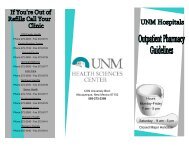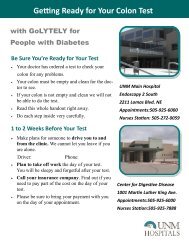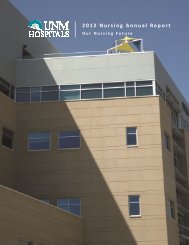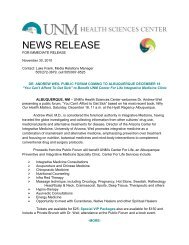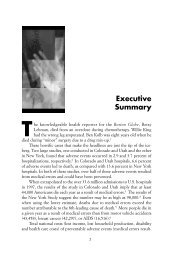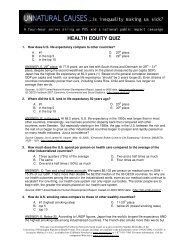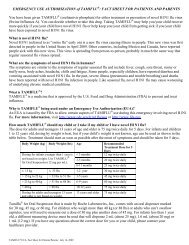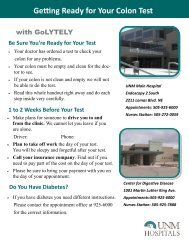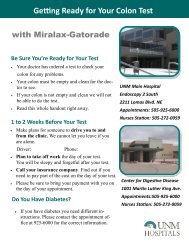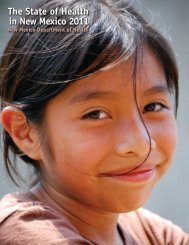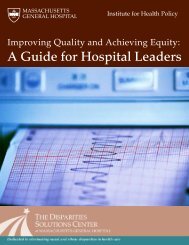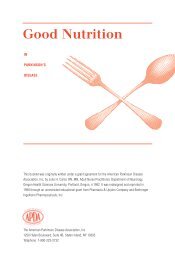Advanced Effective Communication, Cultural Competence, and ...
Advanced Effective Communication, Cultural Competence, and ...
Advanced Effective Communication, Cultural Competence, and ...
You also want an ePaper? Increase the reach of your titles
YUMPU automatically turns print PDFs into web optimized ePapers that Google loves.
A Roadmap for Hospitals<br />
Appendix B: Current Joint Commission Requirements<br />
Joint Commission PC Requirements<br />
PC.01.02.01 The hospital assesses <strong>and</strong><br />
reassesses its patients.<br />
EP 1<br />
EP 2<br />
EP 4<br />
The hospital defines, in writing, the scope <strong>and</strong> content<br />
of screening, assessment, <strong>and</strong> reassessment<br />
information it collects.<br />
Note: In defining the scope <strong>and</strong> content of the<br />
information it collects, the organization may want to<br />
consider information that it can obtain, with the<br />
patient’s consent, from the patient’s family <strong>and</strong> the<br />
patient’s other care providers, as well as information<br />
conveyed on any medical jewelry.<br />
The hospital defines, in writing, criteria that identify<br />
when additional, specialized, or more in-depth<br />
assessments are performed.<br />
Note: Examples of criteria could include those that<br />
identify when a nutritional, functional, or pain<br />
assessment should be performed for patients who are<br />
at risk.<br />
Based on the patient’s condition, information gathered<br />
in the initial assessment includes the following:<br />
• Physical, psychological, <strong>and</strong> social assessment<br />
• Nutrition <strong>and</strong> hydration status<br />
• Functional status<br />
• For patients who are receiving end-of-life care, the<br />
social, spiritual, <strong>and</strong> cultural variables that influence<br />
the patient’s <strong>and</strong> family members’ perception of grief<br />
PC.01.03.01 The hospital plans the patient’s care.<br />
EP 1 The hospital plans the patient’s care, treatment, <strong>and</strong><br />
services based on needs identified by the patient’s<br />
assessment, reassessment, <strong>and</strong> results of diagnostic<br />
testing.<br />
PC.02.02.01 The hospital coordinates the patient’s<br />
care, treatment, <strong>and</strong> services based on the patient’s<br />
needs.<br />
EP 1<br />
EP 3<br />
EP 10<br />
The hospital has a process to receive or share patient<br />
information when the patient is referred to other<br />
internal or external providers of care, treatment, <strong>and</strong><br />
services.<br />
The hospital coordinates the patient’s care, treatment,<br />
<strong>and</strong> services.<br />
Note: Coordination involves resolving scheduling<br />
conflicts <strong>and</strong> duplication of care, treatment, <strong>and</strong><br />
services.<br />
When the hospital uses external resources to meet the<br />
patient’s needs, it coordinates the patient’s care,<br />
treatment, <strong>and</strong> services.<br />
EP 17 The hospital coordinates care, treatment, <strong>and</strong> services<br />
within a time frame that meets the patient’s needs.<br />
PC.02.02.03 The hospital makes food <strong>and</strong> nutrition<br />
products available to its patients.<br />
EP 9 When possible, the hospital accommodates the patient’s<br />
cultural, religious, or ethnic food <strong>and</strong> nutrition<br />
preferences, unless contraindicated.<br />
PC.02.02.13 The patient’s comfort <strong>and</strong> dignity<br />
receive priority during end-of-life care.<br />
EP 1 To the extent possible, the hospital provides care <strong>and</strong><br />
services that accommodate the patient’s <strong>and</strong> his or her<br />
family’s comfort, dignity, psychosocial, emotional, <strong>and</strong><br />
spiritual end-of-life needs<br />
PC.02.03.01 The hospital provides patient<br />
education <strong>and</strong> training based on each patient’s<br />
needs <strong>and</strong> abilities.<br />
EP 1 The hospital performs a learning needs assessment for<br />
each patient, which includes the patient’s cultural <strong>and</strong><br />
religious beliefs, emotional barriers, desire <strong>and</strong><br />
motivation to learn, physical or cognitive limitations, <strong>and</strong><br />
barriers to communication.<br />
Provision of Care, Treatment, <strong>and</strong><br />
Services (PC)<br />
PC st<strong>and</strong>ards address the cyclical process that allows care to be<br />
delivered according to patient needs <strong>and</strong> the hospital’s scope of<br />
services [2]. Existing Joint Commission PC st<strong>and</strong>ards address<br />
care at various points across the care continuum. The Joint<br />
Commission recognizes the need for patients <strong>and</strong> families to be<br />
active <strong>and</strong> informed decision makers throughout the course of<br />
care (see box, above). In order to establish this partnership<br />
between the care provider <strong>and</strong> patient, it is necessary to make<br />
sure that communication is effective.<br />
Part of patient assessment includes the identification of<br />
patient learning needs. In addition, the assessment process<br />
may allow for comprehensive evaluation of other needs that<br />
may impact the patient’s ability to engage with the care team.<br />
These needs are important to consider throughout the care<br />
continuum. Patient’s communication needs, cultural<br />
perspective of health <strong>and</strong> health care, <strong>and</strong> previous experience<br />
with the health system all influence how the patient will<br />
respond to care. In order to foster a healthy relationship with<br />
the patient during the course of care, it is necessary to be<br />
sensitive <strong>and</strong> open to the patient’s individual perspective.<br />
Many st<strong>and</strong>ards in the PC chapter support this.<br />
53



